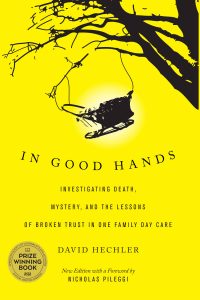Foreword
From In Good Hands by David Hechler
 When two infants died in an Irmo, South Carolina, family day care within nine months, pathologists determined they were the victims of SIDS—sudden infant death syndrome. It seemed like a tragic coincidence, and it might have been dismissed as just that if not for the state police’s newly formed Child Fatalities Department. This innovative unit, created two months before the second death, was designed to ensure that all fatalities of children under 18 were properly investigated. And it soon demonstrated why it was needed.
When two infants died in an Irmo, South Carolina, family day care within nine months, pathologists determined they were the victims of SIDS—sudden infant death syndrome. It seemed like a tragic coincidence, and it might have been dismissed as just that if not for the state police’s newly formed Child Fatalities Department. This innovative unit, created two months before the second death, was designed to ensure that all fatalities of children under 18 were properly investigated. And it soon demonstrated why it was needed.
When the department’s leader, Lt. Patsy Habben, began investigating, she discovered that the first death had never even been been looked into. And without an investigation that ruled out all other possibilities, it didn’t meet the definition of SIDS. As she led the inquiry into the second death, she learned that between the two fatalities another baby who attended the day care had suffered a brain injury. He lived, but doctors found he’d been violently shaken. This alone meant that Child Fatalities was now leading a child
abuse investigation.
Just like that, Habben found that her first big case now had three potential victims. And the unlikely suspects seemed to be Josh and Gail Cutro, the church-going couple who together ran the day care.
David Hechler’s superb book takes us through the complex probe that ensued. The first death was never investigated because two counties were confused about jurisdiction. The case involving the shaking was complicated. The baby’s mother was a recovering drug addict who had previously had a child removed from her care. And when the Cutros felt investigators were suspicious of them, they falsely told the day care parents that the mother had abused her other child. Further complicating matters, the shaking case drew the attention of the sheriff’s department and social workers, but they came to opposite conclusions. The social workers thought the mother was responsible, while the police suspected it was one (or both) of the Cutros.
In Good Hands has enough twists and turns to make you wonder what to believe. Is this a tale about SIDS, a medical mystery that we still don’t understand? Or is it about murder? And if these were murders, what could be the motive? In Irmo, where the Cutros had plenty of supporters, the notion that it was homicide just didn’t compute. Members of the church the Cutros attended rallied around them, and so did the parents who continued to drop off their children— even after the second death. They couldn’t fathom that these people could have harmed children. After all, the Cutros had three children of their own.
Rarely does a book take the reader along through the details and intricacies of such an investigation. Hechler talks to everyone: the investigators, the prosecutors, the defense lawyers, jurors, parents, psychologists, and, finally, Josh and Gail Cutro. I’ve been a fan of Hechler’s for years and, once again, he not only includes all the information his readers need to weigh the evidence for themselves, he makes us feel we were there through the investigation and the trial that follows.
When the trial is finally over, Hechler doesn’t end the book there. He goes back and does the work most writers don’t. He tells us what we should know about these people that wasn’t allowed into evidence in court. What did some parents see that led them to withdraw their children from the day care? Why did other parents defend the Cutros and only remove their children when a court shut the day care down? And what was really going on in that home? The answers may lead some readers to conclude that prosecutors went after the wrong person when they tried Gail Cutro, who had never been in trouble with the law, and not Josh, who had.
Finally, Hechler’s book does something that’s rare in journalism. Not content to simply point out the dangers, the author also focuses on potential solutions by explaining that home day cares, by far the most popular venues, are also virtually unregulated. No government agencies are monitoring the quality of care these children receive, so it’s up to parents to protect their own. The last achievement of In Good Hands is that it informs parents how to help make their children safer.
Nicholas Pileggi
April 2023
Copyright © 2023 David Hechler
